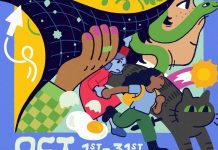by Johanna Draper Carlson
Promising a look into the technological future, “Digital Comics: The Next Page” featured a variety of perspectives on making digital comics. Hosted by Josh Elder, account director at iVerse Media (and writer of Scribblenauts Unmasked for DC), the panel featured
* Jim Chadwick, editor of DC Comics’ DC Squared and digital-first titles, including the popular Injustice
* Jen Brazas, webcomic cartoonist since 2004
* Christina Blanch and Mark Waid, both of Thrillbent, described as a “digital comic platform experimenting with all forms of digital comic distribution in the 21st century”.
iVerse CEO Michael Murphey, originally listed as participating, did not appear.
Normally, discussions of comics online focus on webcomics, but this session, due to the work experience of most of the panelists (and perhaps the overall show audience), talked more about working with big-company products and formats geared to go from digital to print. It was an unusual perspective that hasn’t frequently been discussed.
Elder started the talk by asking “what does ‘digital comic’ mean to you?” Brazas responded that work online is more accessible, reaching an audience outside the traditional comic shop. It’s a medium where niche work can flourish and there are more options for creators to develop audiences. Chadwick continued, pointing out that they have immediate worldwide distribution before discussing the excitement of the options available to creators. “We’re all figuring it out, we’re all trailblazers,” he said, commenting that although things were done one way for a long time, now they’re on the vanguard of reinventing an entire medium, transforming it before our eyes. Blanch noted that there are as many different types of digital comics as there are regular comics.
Taking the opposite tack, Elder then asked about what digital comics aren’t. Waid immediately jumped in, saying they aren’t cheap animation and that “motion comics are the devil’s tools.” His followup points demonstrated a thoughtful approach. He thinks that what makes comics comics is the reader’s ability to determine the pace of the story. The ability for the reader to fill in the voices and what happens in the gutters, using imagination, makes comics an immersive medium. He then demonstrated how Thrillbent uses a landscape format to better suit computer screens and our eyes. Their digital page turns are used to reveal a different image or bring up panels one by one, story guidance effects that can’t be done on a printed page.
Chadwick chimed in that digital comics enhance comics book grammar. Traditional comics control time and pacing with panel shapes and layout. Digital page turns allow that to happen online with new techniques. Elder noted that their tools allow for a lot more reveals; in fact, they almost demand that structure. They can create more suspense, and a digital story tends to have more plot. He smartly pointed out that horror and comedy are both great for the digital format, since they both depend on timing.
Blanch’s first comic writing was for digital, not print. She found Denny O’Neil’s book [The DC Comics Guide to Writing Comics] a help. Thrillbent’s weekly installments have to have something happen and a resolution and a hook every page, which she found difficult. They’re also hard to translate to print, due to the transitions, but she found it neat to look for different ways to tell the story.
Brazas makes her money from selling print collections. Her webcomic is formatted as a page to avoid having to redo work. Pacing then becomes an issue, since pages paced to appear twice a week, with revelations to keep readers interested and provide payoff, would read strangely all in a row in print.
Waid pointed out that print does some things better. Jack Kirby wouldn’t be well-received in digital, he said, because of his immense splash pages and expansive visions. Chadwick agreed, saying splash pages and double-page spreads don’t work well digitally. With DC’s digital products, they always have print in mind on the back end of it.
Elder took a different financial tack, discussing how digital comics lower the barriers to entry. “The economics of experimentation are much better than they ever were,” he said. Brazas then brought up the current topic of Kickstarter. Her first experience with the venue was last year, and she plans to shift to doing all her books that way because it’s “so convenient to have other people pay for the books.”
Waid brought up the idea of a “social contract” to pay a fair price for what you enjoy in media. Big distributors have a place, but an individual artist can connect more directly with an audience and reach the 50,000 who are interested instead of the five million who may or may not be. His mottos it, “Nobody gets rich, everybody gets paid.”
Chadwick added that indy artists have a smaller audience, but one that’s more dedicated, and they may be making more money without a middleman. Then again, the Injustice series was big digital hit, and they released multiple reprintings of the print comic. The hardcover also sold really well. They don’t know, when they start, how long the digital-first series are going to run. It depends on their success, and since the stories are more self-contained, there’s more room to do their own thing.
Waid then reached back to his experience four or so years ago at Baltimore, when retailers expressed a strong resistance to giving anything away for free or online sampling. His take was that we no longer have the luxury of being angry. People stealing your work is awesome, reaching an audience hungry for your material. He wants to figure out a way to make that work for creators, driving them back to the work.
The panel then concluded with questions from the audience.













Thanks for the summary, Johanna!
Comments are closed.